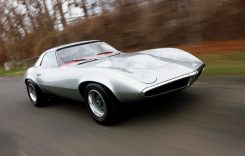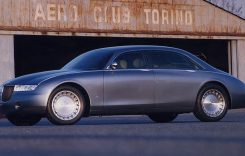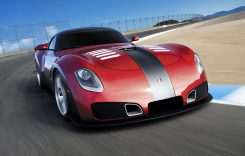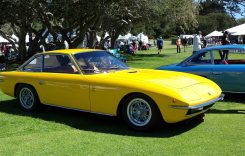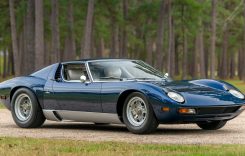Watch out, BMW. Triumph is entering the heavyweight adventure touring division with the Tiger Explorer, and its sights are set squarely on the market leader, the R1200GS. Triumph reports that its sales were up 18% in 2011 despite the sagging economy. At the heart of this upswing is a business plan that puts emphasis on new model development. The Tiger 800 XC was a high mark for the brand last year and the Hinckley, England team is expecting the release of the Explorer for 2012 to be another game-changer.

Triumph looked at the existing adventure market and came up with a list of design points that are necessary to build a competitive AT bike right out of the gate: Comfort and convenience for two, durable and reliable, fully featured and light off-road capability. We visited hospitable Southern Spain to get the details in person and for a quick introduction to the new ADV bruiser. The concept originated in July of 2006, and in four years the first complete bike was up and running. Triumph spent another two years fine-tuning and went into production in January of 2012. Though our time was short, we came away impressed with the Explorer and a better understanding of what this bike can do.
The new Triumph Tiger Explorer is a major contender in the heavyweight adventure touring segment.
Engine performance from the 1215cc Inline Triple is stunning. Each 85mm x 71.4mm cylinder uses an 11.0:1 compression ratio. The power curve is extremely linear and we were unable to detect any surge or miss in the delivery, which is aided by a flywheel. The Explorer boasts a claimed 135 horsepower at 9000 rpm before hitting the rev ceiling 500 rpm later. Torque peaks at 7850 rpm where the Triple churns out a claimed 89.2 lb-ft. Posting big numbers is great, but to ensure usability Triumph says the 12-valve, DOHC Triple makes over 73 lb-ft of torque from as early as 2500 rpm and lasts all the way to the 9500 rpm rev limiter. Until we can put the sleek engine design on our own dyno we won’t discount those claims. However, the important thing is that Triumph’s signature three-cylinder design blends the punch of a Twin while retaining the top-end performance that gives it a high-revving, sporty feel.
A shaft drive delivers the power via a single-sided swingarm which will reduce output in the neighborhood of 15-20%. The Tiger uses a six-speed transmission with hydraulic clutch. It cruises at 75 mph in top gear at around 4200 rpm, which is comfortably devoid of vibrations and capable of overtaking with or without a downshift. We saw an indicated 123 mph on the speedo with more power waiting to be uncorked before running out of road.
Throttle bodies (46mm) for the fuel injection use a motor controlled by the ECU and a ride-by-wire throttle assembly. It offers a light throttle pull and we didn’t have any problems with mid-corner on/off throttle modulation, unlike the Tiger 1050 (which is still in the lineup). The ride-by-wire was designed in conjunction with a cruise control system which comes standard. A simple on/off button prepares the system which is controlled by a set/resume (speed +/-) toggle. It’s a wonderful feature made better by its easy functionality.
Triumph joins Yamaha and BMW in offering a shaft drive. Electronic fuel injection and fly-by-wire throttle allow cruise control also.
Spain’s roadways are a perfect match for the Explorer. The biggest problem as a visiting American is that it’s difficult to decipher the signage, and there’s a ton of it. Without a good sense of what lay ahead, the Tiger allowed us confidence by dropping into sharp hairpins with little effort and the wide bars make rider input very effective. We hustled the Explorer through tight, winding roads that were gas-brake-gas-brake, and the chassis never got unsettled. The engine cranks out the power in the higher rpm and we felt the rear tire spin up on a corner exit, but the chassis, drivetrain and traction control made it entirely comfortable – not something typically said with unexpected pavement powerslides. Transitioning side-to-side is easy with wide aluminum handlebars and a relatively thin layout between the rider’s knees. Weight feels like it is held in a neutral position without the center of gravity being too high.
Kayaba suspension and steel trellis frame allow the Tiger to haul a steady line through fast sweepers or flick through twisties with ease. It’s comfortable for standing and has adjustable seat heights to suit rider preference.
The shaft drive does not squat or rise during acceleration regardless of how hard the throttle is twisted. There’s a ton of feedback from the 46mm inverted Kayaba fork which is preload adjustable. It has 7.5 inches of travel while the rear Kayaba shock offers 7.6 inches. The shock rides on a progressive linkage, is preload adjustable via hand knob and also has control over rebound damping. We didn’t need to change any settings in Spain as we rode solo and without luggage. The suspension feels slightly rigid on pavement irregularities. At times it almost felt too hard, but it’s more of an increased amount of feedback. High-speed G-outs use up the full suspension stroke but it flies across speed bumps and potholes with ease.
At 5’11” our rider had no problems straddling the machine or riding comfortably and in control. The Tiger has a high/low seat height which adjusts from 33.8 to 33.0 inches. Even in the tall setting we could touch both feet nearly flat on the ground. Lower and taller seats are part of 37 available accessories. Riders who need more room in the saddle can reverse the handlebar clamps, though we kept them comfortably in the stock position. The only change we had to make all day was to raise the shift lever one notch and play with the windscreen. It has five different settings and 13 degrees of tilt adjustment which can be altered by hand. We preferred it in the tallest position.
Ducati’s Multistrada has a supercomputer strapped to its front end, but the combination of digital input required to manage it is frustrating at best – even once the rider is accustomed to the process. The Tiger also has a sophisticated dash. Fortunately it’s not nearly as difficult to operate and it still offers more information for the rider than most bikes in its class. Included are a digital speedometer, clock, gear indicator, ambient temperature, dual trip meters with fuel economy, range to empty, distance, time and average speed, fuel gauge, engine temperature and warning lights. Bikes equipped with the TPMS will display psi for front and rear tires. It also uses an analog tachometer. Reading the information is easy to do with just a glance. Riders can set the units, adjust ABS and traction control and choose to make the turn signals self-canceling or not.
We love the instrumentation and electronics.
ABS is an industry standard and traction control is considered a necessity by most manufacturers as well. Triumph has both of these features as part of its base package and they are effective. What we like most is that each is capable of being switched off. A few pushes of the left-side buttons and the bike will brake-slide into corners and drift out of them without any electronic interference. Traction control 1 and 2 are both pointless on the dirt, neither allowing much movement. However, they may offer a more usable range in varying pavement conditions. We tested on the pavement with the standard Level 1 setting in order to get the most assistance and avoid the distracting warning light which flashes when in Level 2 or Off.
Front brakes are dual 305mm rotors with non-radial four-piston Nissin calipers. They provide plenty of power and the initial bite is aggressive without being overly sensitive. The rear brake is a 282mm disc with dual-piston caliper. A large foot pedal makes it easy to access while sitting or standing. The ABS system is very sensitive, kicking in regularly, but it’s not as clunky and noticeable as the BMW system. Front and rear brakes are not linked.
Our ride took a small detour onto a gravel road in order to snag a quick photo, but we didn’t get any real riding time in the dirt. We spent an additional hour at the end of the day collecting video footage which helped give a better feel for the
Triumph designed this bike for “light off-roading.” It’s certainly capable of that. We jumped it and found the aluminum sump guard is a worthy investment.
off-road characteristics, though we’ll have to wait for the Tiger to arrive in America for a full dirt evaluation. Based on the limited experience, the Tiger looks to be a willing off-road partner, and it’s a phenomenal street bike. As with all the big AT bikes, the Explorer is a heavy machine at a claimed 571 pounds (curb, including 5.3 gallons of fuel). Fortunately it does a good job of hiding that weight. It’s easy to plant a foot and spin the rear end, and low-speed riding is fairly stable. Traction from the Metzeler Tourance EXP front tire and Metzeler Tourance EXP rear tire leave a lot to be desired in the dirt, but once we got a feel for the chassis and brakes, the Explorer gets along just fine for a big bike on street tires. The 19-inch front and 17-inch rear wheel help give it some off-road ability. The wheels are cast 10-spokes with tubeless tires.
The Explorer has a muscular, aggressive look that is distinctly part of the Tiger family. Triumph built the engine from the ground up with the intent to minimize external hoses and wires. The effort shows with a very clean and tidy fit and finish. Even the bolts have been given special treatment with drilled hex heads and shaved Torx bolts. The iconic beak that has come to define the ADV category is included, though originally it was going to be an accessory component. The Explorer comes in three colors: Sapphire Blue, Graphite and Phantom Black. Headlights are adjustable and Triumph also includes a centerstand (which does not interfere with the kickstand like the Tiger 800). The engine has a burly alternator which cranks out 950W. That’s plenty of juice to support a wide range of powered accessories including fog lights. Our test model was equipped with the “Launch Package” which has a list of accessories that come factory installed, including: Engine bars, aluminum sump guard, adventure hand guards, heated grips, fog lights, high touring windscreen, rubber tank pad and tire pressure monitoring system (TPMS).
The Tiger Explorer is going to throw a wrench in other manufacturers’ plans. This is the second time in only two years that Triumph has reshaped the adventure-touring market with an exciting and capable new motorcycle.
Triumph swung for the fences with the Tiger 800. That project turned out a winner and the Tiger Explorer has resulted in an equally impressive machine. Not only has Triumph matched the current crop of premium ADV bikes in performance, but it also packs the big Tiger with features that are largely unmatched and range from engine design and electronics to ergonomics and rider accessories. It’s a lot of bike for the $15,699 base price, and is right in the mix with the competition’s prices (BMW R1200GS – $16,150; Yamaha Super Tenere – $14,500; Ducati Multistrada – $16,995). Triumph also boasts 10,000-mile service intervals (20,000 between major services) and sweetens the purchase deal with a two-year unlimited mile warranty. The Brits make no effort to shy away from the fact that they wants to steal customers from the Bavarians, going so far as to predict undercutting the GS by 3% in worldwide markets. Triumph surely swiped some sales with the Tiger 800, and after our short introduction, we’re sure that BMW and the rest of the manufacturers are going to feel the impact of the Explorer.
